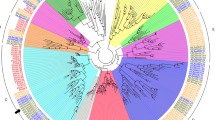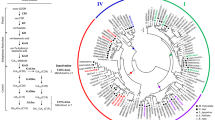Abstract
Symbiotic nitrogen fixation is benefit to sustainable agriculture and global nitrogen cycle. Many small peptides were identified as regulators involving in the interaction between rhizobia and legume. Here we reported Nodule Rich Protein 2 (MtNRP2) encoding a small peptide in Medicago truncatula, belonged to a group of nodule rich protein restricted in legume species. MtNRP2 expressed highly in root nodule and its promoter was active during the initiation and development of root nodule and lateral root. To investigate the function of MtNRP2 in nodulation, we generated MtNRP2-overexpression and MtNRP2-knockdown transgenic Medicago. MtNRP2-overexpression transgenic lines performed normal nodulation phenotype compared with vector control. However, in the MtNRP2-RNAi transgenic plants, the decrease of MtNRP2 expression lead to the increase of infection threads number (7 day post inoculation) and nodules number (3 week post inoculation); meanwhile, the expression of MtRGF3 and MtPUB1 was inhibited. These results suggested that MtNRP2 negatively regulated nodulation in Medicago truncatula.




Similar content being viewed by others
References
An Z, Liu Y, Ou Y, Li J, Zhang B, Sun D, Sun Y, Tang W (2018) Regulation of the stability of RGF1 receptor by the ubiquitin-specific proteases UBP12/UBP13 is critical for root meristem maintenance. Proceedings of the National Academy of Sciences
Boisson-Dernier A, Chabaud M, Garcia F, Bécard G, Rosenberg C, Barker DG (2001) Agrobacterium rhizogenes-transformed roots of Medicago truncatula for the study of nitrogen-fixing and endomycorrhizal symbiotic associations. Mol Plant Microbe Interact 14:695–700
Boschiero C, Dai X, Lundquist PK, Roy S, Christian de Bang T, Zhang S, Zhuang Z, Torres-Jerez I, Udvardi MK, Scheible WR, Zhao PX (2020) MtSSPdb: the Medicago truncatula small secreted peptide database. Plant Physiol 183:399–413
Combier JP, Küster H, Journet EP, Hohnjec N, Gamas P, Niebel A (2008) Evidence for the involvement in nodulation of the two small putative regulatory peptide-encoding genes MtRALFL1 and MtDVL1. Mol Plant Microbe Interact 21:1118–1127
Cosson V, Eschstruth A, Ratet P (2015) Medicago truncatula transformation using leaf explants. Methods in molecular biology (Clifton, N.J.) 1223:43–56
de Bang TC, Lundquist PK, Dai X, Boschiero C, Zhuang Z, Pant P, Torres-Jerez I, Roy S, Nogales J, Veerappan V, Dickstein R, Udvardi MK, Zhao PX, Scheible WR (2017) Genome-wide identification of medicago peptides involved in macronutrient responses and nodulation. Plant Physiol 175:1669–1689
Djordjevic MA, Mohd-Radzman NA, Imin N (2015) Small-peptide signals that control root nodule number, development, and symbiosis. J Exp Bot 66:5171–5181
Ferguson BJ, Li D, Hastwell AH, Reid DE, Li Y, Jackson SA, Gresshoff PM (2014) The soybean (Glycine max) nodulation-suppressive CLE peptide, GmRIC1, functions interspecifically in common white bean (Phaseolus vulgaris), but not in a supernodulating line mutated in the receptor PvNARK. Plant Biotechnol J 12:1085–1097
Fletcher JC (2020) Recent advances in arabidopsis CLE peptide signaling. Trends Plant Sci
Imin N, Mohd-Radzman NA, Ogilvie HA, Djordjevic MA (2013) The peptide-encoding CEP1 gene modulates lateral root and nodule numbers in Medicago truncatula. J Exp Bot 64:5395–5409
Kereszt A, Mergaert P, Montiel J, Endre G, Kondorosi É (2018) Impact of plant peptides on symbiotic nodule development and functioning. Front Plant Sci 9:1026
Laffont C, Huault E, Gautrat P, Endre G, Kalo P, Bourion V, Duc G, Frugier F (2019) Independent regulation of symbiotic nodulation by the SUNN negative and CRA2 positive systemic pathways. Plant Physiol 180:559–570
Li X, Xu J, Yu G, Luo L (2012) A wound-induced small polypeptide gene family is upregulated in soybean nodules. Chin Sci Bull 57:2948–2955
Li Q, Li M, Zhang D, Yu L, Yan J, Luo L (2020) The peptide-encoding MtRGF3 gene negatively regulates nodulation of Medicago truncatula. Biochem Biophys Res Commun 523:66–71
Mahmud K, Makaju S, Ibrahim R, Missaoui A (2020) Current progress in nitrogen fixing plants and microbiome research. Plants 9:97
Maróti G, Kondorosi E (2014) Nitrogen-fixing Rhizobium-legume symbiosis: are polyploidy and host peptide-governed symbiont differentiation general principles of endosymbiosis? Front Microbiol 5:326
Mbengue M, Camut S, de Carvalho-Niebel F, Deslandes L, Froidure S, Klaus-Heisen D, Moreau S, Rivas S, Timmers T, Herve C, Cullimore J, Lefebvre B (2010) The Medicago truncatula E3 ubiquitin ligase PUB1 interacts with the LYK3 symbiotic receptor and negatively regulates infection and nodulation. Plant Cell 22:3474–3488
Montiel J, Downie JA, Farkas A, Bihari P, Herczeg R, Bálint B, Mergaert P, Kereszt A, Kondorosi É (2017) Morphotype of bacteroids in different legumes correlates with the number and type of symbiotic NCR peptides. Proc Natl Acad Sci U S A 114:5041–5046
Mortier V, Den Herder G, Whitford R, Van de Velde W, Rombauts S, D’Haeseleer K, Holsters M, Goormachtig S (2010) CLE peptides control Medicago truncatula nodulation locally and systemically. Plant Physiol 153:222–237
Nowak S, Schnabel E, Frugoli J (2019) The Medicago truncatula CLAVATA3-LIKE CLE12/13 signaling peptides regulate nodule number depending on the CORYNE but not the COMPACT ROOT ARCHITECTURE2 receptor. Plant Signal Behav 14:1598730
Oh E, Seo PJ, Kim J (2018) Signaling peptides and receptors coordinating plant root development. Trends Plant Sci 23:337–351
Okamoto S, Shinohara H, Mori T, Matsubayashi Y, Kawaguchi M (2013) Root-derived CLE glycopeptides control nodulation by direct binding to HAR1 receptor kinase. Nat Commun 4:2191
Oldroyd GE (2013) Speak, friend, and enter: signalling systems that promote beneficial symbiotic associations in plants. Nat Rev Microbiol 11:252–263
Pan H, Wang D (2017) Nodule cysteine-rich peptides maintain a working balance during nitrogen-fixing symbiosis. Nat Plants 3:17048
Pankievicz VCS, Irving TB, Maia LGS, Ané JM (2019) Are we there yet? The long walk towards the development of efficient symbiotic associations between nitrogen-fixing bacteria and non-leguminous crops. BMC Biol 17:99
Rogers C, Oldroyd GE (2014) Synthetic biology approaches to engineering the nitrogen symbiosis in cereals. J Exp Bot 65:1939–1946
Roy S, Liu W, Nandety RS, Crook A, Mysore KS, Pislariu CI, Frugoli J, Dickstein R, Udvardi MK (2020) Celebrating 20 years of genetic discoveries in legume nodulation and symbiotic nitrogen fixation. Plant Cell 32:15–41
Song W, Liu L, Wang JZ, Wu Z, Zhang HQ, Tang J, Lin GZ, Wang YC, Wen X, Li WY, Han ZF, Guo HW, Chai JJ (2016) Signature motif-guided identification of receptors for peptide hormones essential for root meristem growth. Cell Res 26:674–685
Stonoha-Arther C, Wang D (2018) Tough love: accommodating intracellular bacteria through directed secretion of antimicrobial peptides during the nitrogen-fixing symbiosis. Curr Opin Plant Biol 44:155–163
Taleski M, Imin N, Djordjevic MA (2018) CEP peptide hormones: key players in orchestrating nitrogen-demand signalling, root nodulation, and lateral root development. J Exp Bot 69:1829–1836
Vernie T, Camut S, Camps C, Rembliere C, de Carvalho-Niebel F, Mbengue M, Timmers T, Gasciolli V, Thompson R, le Signor C, Lefebvre B, Cullimore J, Herve C (2016) PUB1 interacts with the receptor kinase DMI2 and negatively regulates rhizobial and arbuscular mycorrhizal symbioses through its ubiquitination activity in Medicago truncatula. Plant Physiol 170:2312–2324
Wang C, Yu H, Zhang Z, Yu L, Xu X, Hong Z, Luo L (2015) Phytosulfokine is involved in positive regulation of Lotus japonicus nodulation. Mol Plant Microbe Interact 28:847–855
Wang C, Yu H, Luo L, Duan L, Cai L, He X, Wen J, Mysore KS, Li G, Xiao A, Duanmu D, Cao Y, Hong Z, Zhang Z (2016) NODULES WITH ACTIVATED DEFENSE 1 is required for maintenance of rhizobial endosymbiosis in Medicago truncatula. New Phytol 212:176–191
Zhu F, Deng J, Chen H, Liu P, Zheng L, Ye Q, Li R, Brault M, Wen J, Frugier F, Dong J, Wang T (2020) A CEP peptide receptor-like kinase regulates auxin biosynthesis and ethylene signaling to coordinate root growth and symbiotic nodulation in Medicago truncatula. Plant Cell
Acknowledgements
This research was funded by the National Natural Science Foundation of China (31570241 and 31900214).
Author information
Authors and Affiliations
Corresponding author
Additional information
Publisher's Note
Springer Nature remains neutral with regard to jurisdictional claims in published maps and institutional affiliations.
Supplementary Information
Below is the link to the electronic supplementary material.
Rights and permissions
About this article
Cite this article
Yan, J., Yang, X., Wang, Y. et al. Nodule Rich Protein 2 modulates nodule number in Medicago truncatula. Plant Biotechnol Rep 15, 109–116 (2021). https://doi.org/10.1007/s11816-020-00658-x
Received:
Revised:
Accepted:
Published:
Issue Date:
DOI: https://doi.org/10.1007/s11816-020-00658-x




